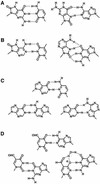Mutagenic potentials of damaged nucleic acids produced by reactive oxygen/nitrogen species: approaches using synthetic oligonucleotides and nucleotides: survey and summary
- PMID: 12527759
- PMCID: PMC140503
- DOI: 10.1093/nar/gkg137
Mutagenic potentials of damaged nucleic acids produced by reactive oxygen/nitrogen species: approaches using synthetic oligonucleotides and nucleotides: survey and summary
Abstract
DNA and DNA precursors (deoxyribonucleotides) suffer damage by reactive oxygen/nitrogen species. They are important mutagens for organisms, due to their endogenous formation. Damaged DNA and nucleotides cause alterations of the genetic information by the mispairing properties of the damaged bases, such as 8-hydroxyguanine (7,8-dihydro-8-oxoguanine) and 2-hydroxyadenine. Here, the author reviews the mutagenic potentials of damaged bases in DNA and of damaged DNA precursors formed by reactive oxygen/nitrogen species, focusing on the results obtained with synthetic oligonucleotides and 2'-deoxyribonucleoside 5'-triphosphates.
Figures


References
-
- Ames B.N. (1983) Dietary carcinogens and anticarcinogens. Science, 221, 1256–1264. - PubMed
-
- Wallace S.S. (1998) Enzymatic processing of radiation-induced free radical damage in DNA. Radiat. Res., 150, S60–S79. - PubMed
-
- Halliwell B. and Aruoma,O.I. (1991) DNA damage by oxygen-derived species. Its mechanism and measurement in mammalian systems. FEBS Lett., 281, 9–19. - PubMed

